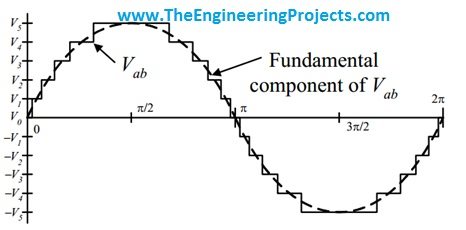
An inverter, also named a power inverter, is an electrical power device that is used to convert direct current (DC) into alternating current (AC). Using a few control circuits and switches, one can get AC at any required voltage and frequency. Inverter plays exactly the opposite role of rectifiers as rectifiers are used for converting alternating current (AC) into direct current (DC). There are different types of inverters available these days. You should also have a look at Pure Sine wave Inverter Design with code and Modified Sine Wave Inverter Design with code. I think you are gonna like that one. Few most commonly used inverter types are:
- Square wave inverters
- Modified sine wave inverters
- Multilevel inverters
- Pure sine wave inverters
- Resonant inverters
- Grid-tie inverters
- Synchronous inverters
- Stand-alone inverters
- Solar inverters
Introduction to Multilevel Inverter
- A multilevel inverter is a power electronic device that is capable of providing desired alternating voltage level at the output using multiple lower-level DC voltages as an input.
- Mostly a two-level inverter is used in order to generate the AC voltage from DC voltage.
Concept of Multilevel Inverter
First, take the case of a two-level inverter. A two-level Inverter creates two different voltages for the load i.e. suppose we are providing Vdc as an input to a two-level inverter then it will provide + Vdc/2 and – Vdc/2 on output. In order to build an AC voltage, these two newly generated voltages are usually switched. For switching mostly PWM is used as shown in Figure 2.1, reference wave is shown in the dashed blue line. Although this method of creating AC is effective but it has few drawbacks as it creates harmonic distortions in the output voltage and also has a high dv/dt as compared to that of a multilevel inverter. Normally this method works but in few applications, it creates problems particularly those where low distortion in the output voltage is required.

The concept of multilevel Inverter (MLI) is a kind of modification of a two-level inverter. In multilevel inverters we don’t deal with the two-level voltage instead in order to create a smoother stepped output waveform, more than two voltage levels are combined together and the output waveform obtained in this case has lower dv/dt and also lower harmonic distortions. The smoothness of the waveform is proportional to the voltage levels, as we increase the voltage level the waveform becomes smoother but the complexity of the controller circuit and components also increases along with the increased levels. The waveform for the three, five and seven level inverters are shown in the below figure, where we clearly see that as the levels are increasing, the waveform becoming smoother.

Multilevel Inverter Topologies
There are several topologies of multilevel inverters available. The difference lies in the mechanism of switching and the source of input voltage to the multilevel inverters. Three most commonly used multilevel inverter topologies are:
- Cascaded H-bridge multilevel inverters.
- Diode Clamped multilevel inverters.
- Flying Capacitor multilevel inverters.
1. Cascaded H-bridge Multilevel Inverters
This inverter uses several H-bridge inverters connected in series to provide a sinusoidal output voltage. Each cell contains one H-bridge and the output voltage generated by this multilevel inverter is actually the sum of all the voltages generated by each cell i.e. if there are k cells in an H-bridge multilevel inverter then a number of output voltage levels will be 2k+1. This type of inverter has an advantage over the other two as it requires fewer components as compared to the other two types of inverters and so its overall weight and price are also less. Below Figure shows a k level cascaded H-bridge inverter.

In a single-phase inverter, each phase is connected to a single dc source. Each level generates three voltages which are positive, negative and zero. This can be obtained by connecting the AC source with the DC output and then using different combinations of the four switches. The inverter will remain ON when two switches with opposite positions will remain ON. It will turn OFF when all the inverters switch ON or OFF. To minimize the total harmonic distortion, switching angles are defined and implemented. The calculations for the measurement of switching angle will remain the same. This inventor can be categorized further into the following types:
- 5 levels cascaded H Bridge Multilevel Inverter
- 9 levels cascaded H Bridge Multilevel Inverter
In 5 level cascaded H Bridge Multilevel Inverters, Two H Bridge Inverters are cascaded. It has 5 levels of output and uses 8 switching devices to control whereas in 9 level cascaded H Bridge Multilevel Inverters, Four H Bridge Invertors are cascaded. It has 9 output levels and use and use 16 switching devices.
Applications of Cascaded H-bridge Multilevel Inverters
Cascaded H Bridge Multilevel Inverters are mostly used for static var applications i.e., in renewable resources’ of energy and battery based applications. Cascaded H Bridge Multilevel Inverters can be applied as a delta or wye form. This can be understood by looking at the work done by Peng where he used an electrical system parallel with a Cascade H Bridge. Here inverter is being controlled by regulating the power factor. Best application is when we used as photovoltaic cell or fuel cell. This is the example of Parallel connectivity of the H Bridge Multilevel Inverter.
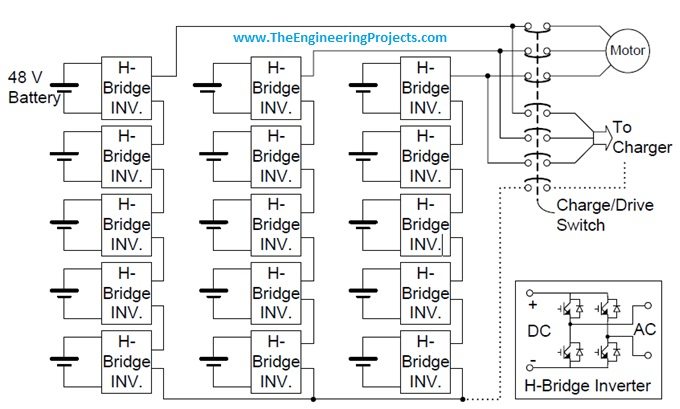
H Bridge can also be used in car batteries to run the electrical components of the car. Also, this can be used in the electrical braking systems of the vehicles.
Scientists and engineers have also proposed the multiplicative factor on Cascade H Bridge Multilevel. It means that rather than using a dc voltage with the difference in levels, it uses a multiplying factor between different levels of the multilevel i.e., every level is a multiplying factor of the previous one.Advantages of Cascade H Bridge Multilevel Inverters
- Output voltages levels are doubled the number of sources
- Manufacturing can be done easily and quickly
- Packaging and Layout are modularized.
- Easily controllable with a transformer as shown in the Fig 2.5
- Cheap
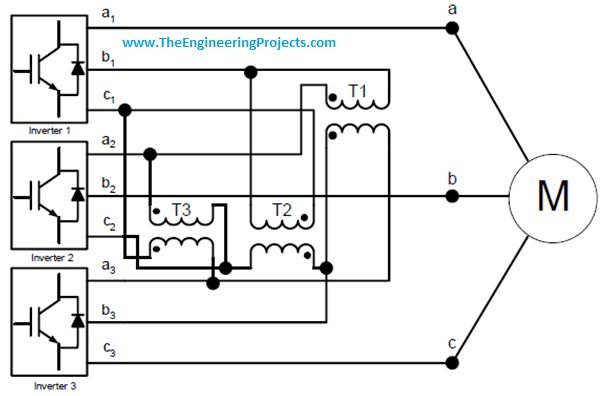
Disadvantages of Cascade H Bridge Multilevel Inverters
- Every H Bridge needs a separate dc source.
- Limited applications due to a large number of sources.
2. Diode Clamped Multilevel Inverters
Diode clamped multilevel inverters use clamping diodes in order to limit the voltage stress of power devices. It was first proposed in 1981 by Nabae, Takashi and Akagi and it is also known as a neutral point converter. A k level diode clamped inverter needs (2k – 2) switching devices, (k – 1) input voltage source and (k – 1) (k – 2) diodes in order to operate. Vdc is the voltage present across each diode and the switch. Single-phase diode clamped multilevel inverter is shown in the figure below:
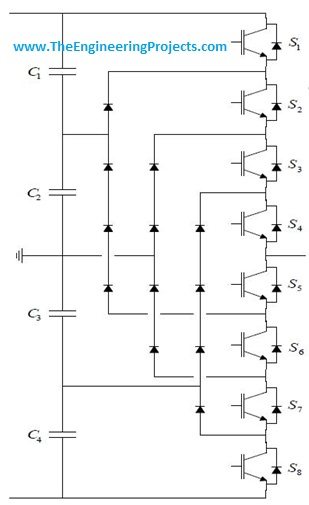
The concept of diode clamped inverter can better be understood by looking into a three-phase six-level diode clamped inverter. Here the common dc bus is shared by all the phases, use five capacitors and six levels. Each capacitor has a voltage of Vdc and same is the voltage limit of switching devices. One important fact should be noted while considering the diode clamped inverter is that five switches will remain ON at any time. Six level, three-phase dc clamped multilevel inverter is shown in the figure below.
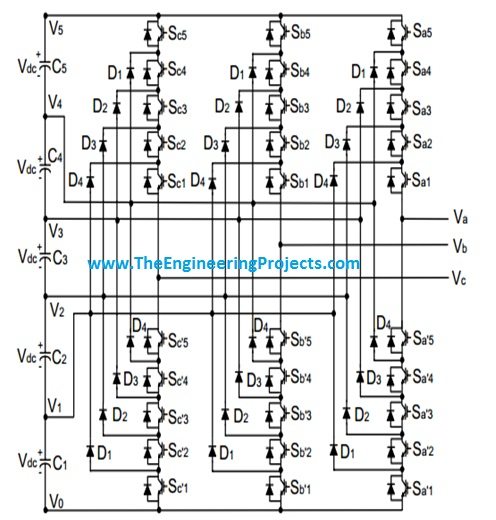
Outputs of each phase can be understood by the following table. Here reference voltage is the negative Vo. Condition 0 means switch is OFF and vice versa. Output waveforms of six level dc clamped inverter is shown below:

Applications of Diode Clamped Multilevel Inverters
The most common application of diode clamped multilevel inverter is when a high voltage Dc and Ac transmission lines are interfaced. This can also be used in variable speed control of high power drives. Static variable compensation is also an application of diode clamped multilevel inverters.
Advantages of Diode Clamped Multilevel Inverters
- The capacitance of the capacitors used is low.
- Back-to-back inverters can be used.
- Capacitors are precharged.
- At fundamental frequency, efficiency is high.
Disadvantages of Diode Clamped Multilevel Inverters
- Clamping diodes are increased with the increase of each level.
- The DC level will discharge when control and monitoring are not precise.
3. Flying Capacitor Multilevel Inverters
The configuration of this inverter topology is quite similar to previous one except the difference that here flying capacitors is used in order to limit the voltage instead of diodes. The input DC voltages are divided by the capacitors here. The voltage over each capacitor and each switch is Vdc. A k level flying capacitor inverter with (2k – 2) switches will use (k – 1) number of capacitors in order to operate. The figure below shows a five-level flying capacitor multilevel inverter.
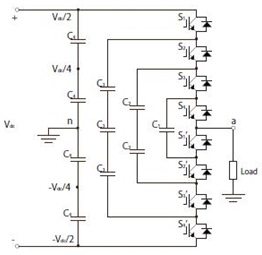
If we compare above figures, it shows that the number of switches, main diodes and DC-bus capacitors are same in both the cases. The only difference between the two topologies is that the previous one uses clamping diodes in order to limit the voltage while this topology uses flying capacitors for this purpose, and as capacitors are incapable of blocking the reverse voltage, which diodes do, the number of switches also increases. Voltage on each capacitor is differing from the next as it has a ladder structure. Voltage difference between two back to back capacitors determines the voltage in the output frame.
Advantages of Flying Capacitor Multilevel Inverters
Static var generation is the best application of Capacitor Clamped Multilevel Inverters.- For balancing capacitors’ voltage levels, phase redundancies are available.
- We can control reactive and real power flow.
Disadvantages of Flying Capacitor Multilevel Inverters
- Voltage control is difficult for all capacitors.
- Complex startup.
- Switching efficiency is poor.
- Capacitors are expensive than diodes.



